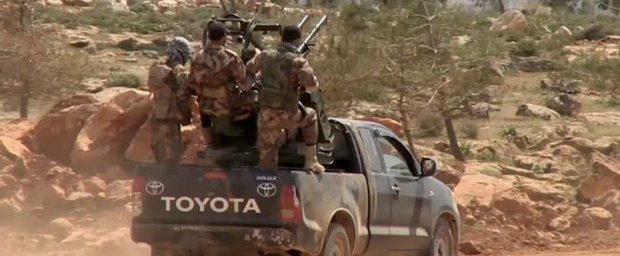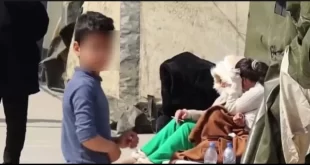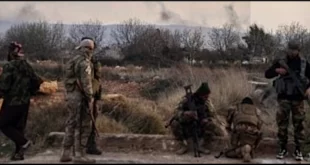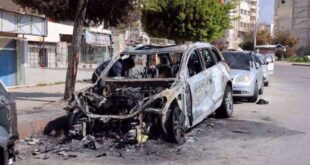May 26, 2014, McClatchy
[VISIT ORIGINAL SOURCE TO VIEW 2 BRIEF VIDEO CLIPS FROM THE DOC]
With reports indicating that forces loyal to Syrian President Bashar Assad are gaining ground in that country’s brutal civil war, moderate Syrian rebels have told a visiting journalist that the United States is arranging their training in Qatar.
In a documentary to be aired Tuesday night, the rebels describe their clandestine journey from the Syrian battlefield to meet with their American handlers in Turkey and then travel on to Qatar, where they say they received training in the use of sophisticated weapons and fighting techniques, including, one rebel said, “how to finish off soldiers still alive after an ambush.”
The interviews are the latest evidence that after more than three years of warfare, the United States has stepped up the provision of lethal aid to the rebels. In recent months, at least five rebel units have posted videos showing their members firing U.S.-made TOW anti-tank missiles at Syrian positions. The weapons are believed to have come from Saudi Arabia, but experts on international arms transfers have told McClatchy that they could not have been given to the rebels without the approval of the Obama administration.
The documentary, produced by Frontline for airing on PBS stations, features journalist Muhammad Ali, who has been following the Syrian civil war for the program. It shows Ali meeting up with a seemingly moderate faction of the rebels, though the faction itself is not identified _ apparently for fear of angering its American contacts.
Ali is shown riding with a rebel supply officer as he traveled to the Turkish border to reportedly pick up American-supplied Russian weapons and ammunition, but he is not allowed to accompany the fighters to the actual meeting. When the rebels return to pick him up, they display bullets and a mortar, which are shown in the film, and tell him they have received TOW missiles; the missiles are not shown, however.
The commander of the unit also told Ali that their American contacts had asked him to bring 80 to 90 members of his unit to Ankara for training. Once in Ankara, after a 14-hour drive from Syria, they were interrogated for days about their political leanings and their unit’s fighting history. The commander told Ali that their questioners identified themselves as belonging to “the military,” but that he believed they were from the CIA.
On the final day, they were told that they would be flown the next day to a training camp in Qatar, a monarchy in the Persian Gulf. Then they were transported to a training facility they believed was near the border with Saudi Arabia.
One of the fighters said they received three weeks of training in how to conduct ambushes, conduct raids and use their weapons. They also said they received new uniforms and boots.
“They trained us to ambush regime or enemy vehicles and cut off the road,” said the fighter, who is identified only as “Hussein.” “They also trained us on how to attack a vehicle, raid it, retrieve information or weapons and munitions, and how to finish off soldiers still alive after an ambush.”
But whether such aid from the United States helps bring the peace in the form of negotiation or extend the war by giving the rebels false hope remains unclear.
Indeed, the fighters told Ali that they cannot win without anti-aircraft missiles against Assad superior air war, which they have yet to receive.
“When I saw there was no training in anti-aircraft missiles, my morale was destroyed,” one fighter told Ali.
For the United States, its new effort means treading slowly into murky waters. In the last few months, the United States has signaled it is increasingly interested in finding an ally that can force Assad to the negotiation table and curtail the burgeoning al Qaida threat coming from extremist groups fighting Assad.
The United States has refused to confirm its growing efforts to help the fighters. Neither the Pentagon nor the CIA would comment on Frontline’s findings.
For the United States, publicly embracing such an effort presents many challenges, chief among them widespread opposition among U.S. voters for more direct U.S. involvement in the Syrian conflict. When the United States was considering a military strike on Syria last summer after a chemical weapons attack in the Damascus suburbs, polling showed overwhelming opposition to U.S. military intervention.
Moreover, many both inside and out of government fear U.S.-provided weapons could make their way into extremist hands, particularly in a place like Syria, where alliances and foes change with breakneck fluidity. Moderate rebel groups have worked closely with the al Qaida-aligned Nusra Front and the Islamic Front, one of whose factions, Ahrar al Sham, includes al Qaida members among its founders.
Perhaps because of those reasons, Congress has never publicly signed off on funding for a training and arming effort, and officially, the United States only provides non-lethal aid, like food rations, clothing and first aid supplies.
 Syria Support Movement solidarity with the Syrian people
Syria Support Movement solidarity with the Syrian people





